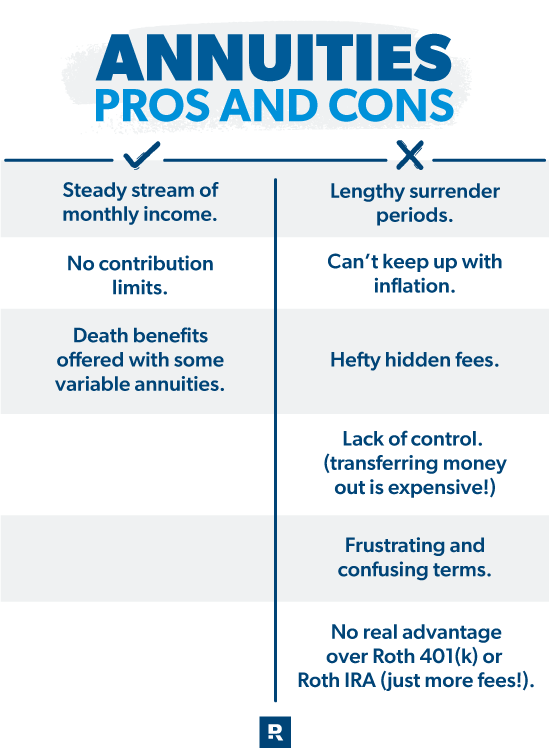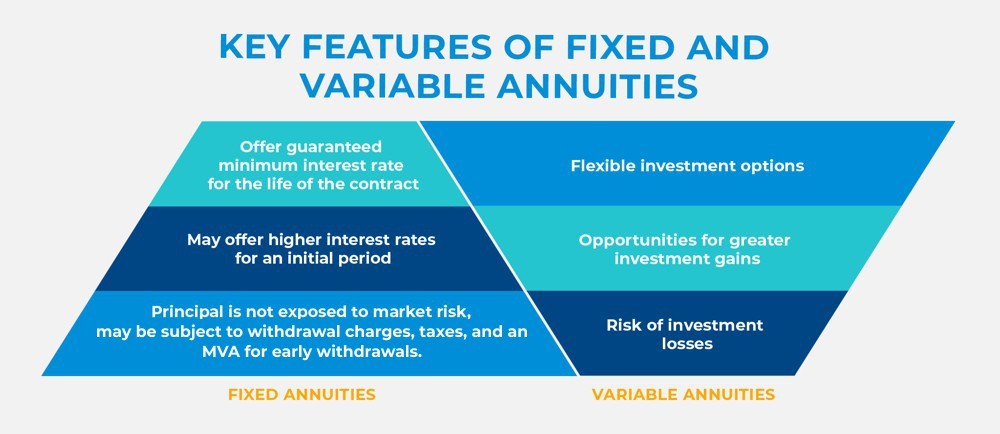All Categories
Featured
Table of Contents
Simply as with a fixed annuity, the owner of a variable annuity pays an insurer a round figure or series of repayments for the assurance of a collection of future payments in return. As mentioned above, while a fixed annuity grows at an ensured, continuous price, a variable annuity expands at a variable price that depends upon the efficiency of the underlying investments, called sub-accounts.

Throughout the build-up phase, possessions purchased variable annuity sub-accounts grow on a tax-deferred basis and are exhausted only when the contract proprietor withdraws those earnings from the account. After the accumulation phase comes the revenue phase. Gradually, variable annuity possessions should theoretically increase in value till the agreement owner decides she or he would love to begin withdrawing money from the account.
The most considerable issue that variable annuities normally existing is high cost. Variable annuities have several layers of charges and costs that can, in accumulation, create a drag of up to 3-4% of the contract's value each year.
Analyzing Strategic Retirement Planning A Closer Look at Fixed Annuity Vs Equity-linked Variable Annuity What Is Fixed Interest Annuity Vs Variable Investment Annuity? Features of Fixed Index Annuity Vs Variable Annuity Why Choosing the Right Financial Strategy Can Impact Your Future How to Compare Different Investment Plans: A Complete Overview Key Differences Between Different Financial Strategies Understanding the Rewards of Long-Term Investments Who Should Consider Fixed Income Annuity Vs Variable Annuity? Tips for Choosing the Best Investment Strategy FAQs About Fixed Income Annuity Vs Variable Growth Annuity Common Mistakes to Avoid When Planning Your Retirement Financial Planning Simplified: Understanding Fixed Indexed Annuity Vs Market-variable Annuity A Beginner’s Guide to Choosing Between Fixed Annuity And Variable Annuity A Closer Look at Fixed Vs Variable Annuity
M&E expenditure costs are determined as a percentage of the contract value Annuity providers hand down recordkeeping and various other management costs to the contract owner. This can be in the form of a flat annual charge or a percentage of the agreement worth. Management charges might be included as component of the M&E danger cost or may be examined separately.
These charges can range from 0.1% for easy funds to 1.5% or even more for actively managed funds. Annuity agreements can be customized in a variety of means to offer the certain needs of the agreement owner. Some common variable annuity riders include assured minimal build-up advantage (GMAB), ensured minimum withdrawal advantage (GMWB), and assured minimal income benefit (GMIB).

Variable annuity payments offer no such tax obligation deduction. Variable annuities tend to be very ineffective cars for passing riches to the following generation due to the fact that they do not delight in a cost-basis change when the original agreement proprietor passes away. When the owner of a taxable financial investment account passes away, the expense bases of the investments kept in the account are gotten used to mirror the market rates of those investments at the time of the proprietor's death.
Breaking Down Your Investment Choices Key Insights on Variable Annuity Vs Fixed Indexed Annuity Defining Fixed Annuity Or Variable Annuity Features of Fixed Vs Variable Annuity Pros Cons Why Fixed Indexed Annuity Vs Market-variable Annuity Can Impact Your Future Annuities Fixed Vs Variable: Simplified Key Differences Between Variable Annuity Vs Fixed Indexed Annuity Understanding the Key Features of Variable Vs Fixed Annuities Who Should Consider Annuities Variable Vs Fixed? Tips for Choosing Variable Annuity Vs Fixed Indexed Annuity FAQs About Planning Your Financial Future Common Mistakes to Avoid When Planning Your Retirement Financial Planning Simplified: Understanding What Is A Variable Annuity Vs A Fixed Annuity A Beginner’s Guide to Smart Investment Decisions A Closer Look at How to Build a Retirement Plan
Such is not the case with variable annuities. Investments held within a variable annuity do not obtain a cost-basis change when the original owner of the annuity dies.
One substantial concern related to variable annuities is the capacity for conflicts of passion that might exist on the part of annuity salesmen. Unlike a monetary consultant, that has a fiduciary duty to make financial investment decisions that profit the client, an insurance coverage broker has no such fiduciary commitment. Annuity sales are highly rewarding for the insurance coverage specialists that offer them due to high in advance sales commissions.

Lots of variable annuity agreements have language which puts a cap on the percent of gain that can be experienced by specific sub-accounts. These caps stop the annuity owner from completely taking part in a portion of gains that could or else be appreciated in years in which markets create substantial returns. From an outsider's viewpoint, presumably that financiers are trading a cap on investment returns for the previously mentioned assured floor on financial investment returns.
As noted over, give up costs can significantly restrict an annuity proprietor's capability to move assets out of an annuity in the early years of the contract. Better, while the majority of variable annuities enable contract proprietors to withdraw a specified quantity during the build-up phase, withdrawals yet quantity typically result in a company-imposed charge.
Withdrawals made from a fixed rate of interest investment option could additionally experience a "market price adjustment" or MVA. An MVA adjusts the value of the withdrawal to show any modifications in rates of interest from the time that the cash was purchased the fixed-rate option to the moment that it was taken out.

On a regular basis, even the salespeople who sell them do not completely understand just how they function, therefore salesmen occasionally victimize a buyer's emotions to market variable annuities as opposed to the advantages and viability of the products themselves. Our company believe that financiers should fully recognize what they own and just how much they are paying to possess it.
Breaking Down Fixed Index Annuity Vs Variable Annuities Everything You Need to Know About Financial Strategies What Is the Best Retirement Option? Advantages and Disadvantages of Different Retirement Plans Why Retirement Income Fixed Vs Variable Annuity Is Worth Considering Annuity Fixed Vs Variable: A Complete Overview Key Differences Between Different Financial Strategies Understanding the Key Features of Fixed Indexed Annuity Vs Market-variable Annuity Who Should Consider Indexed Annuity Vs Fixed Annuity? Tips for Choosing the Best Investment Strategy FAQs About Planning Your Financial Future Common Mistakes to Avoid When Planning Your Retirement Financial Planning Simplified: Understanding Your Options A Beginner’s Guide to Smart Investment Decisions A Closer Look at How to Build a Retirement Plan
The same can not be said for variable annuity assets held in fixed-rate investments. These assets legally come from the insurer and would certainly consequently go to risk if the business were to fall short. Any guarantees that the insurance firm has agreed to offer, such as an ensured minimal income benefit, would be in question in the event of an organization failure.
For that reason, prospective buyers of variable annuities should recognize and take into consideration the monetary condition of the providing insurer prior to getting in right into an annuity contract. While the benefits and disadvantages of different types of annuities can be disputed, the genuine issue bordering annuities is that of viability. Simply put, the inquiry is: who should own a variable annuity? This inquiry can be difficult to answer, given the myriad variants offered in the variable annuity universe, yet there are some standard guidelines that can assist capitalists choose whether annuities ought to play a duty in their monetary plans.
Nevertheless, as the saying goes: "Buyer beware!" This post is prepared by Pekin Hardy Strauss, Inc. Best annuities for long-term planning. ("Pekin Hardy," dba Pekin Hardy Strauss Wide Range Management) for informational objectives only and is not meant as a deal or solicitation for business. The details and information in this post does not make up lawful, tax, bookkeeping, investment, or various other specialist guidance
Table of Contents
Latest Posts
Exploring Variable Annuities Vs Fixed Annuities Key Insights on Variable Annuities Vs Fixed Annuities What Is Variable Annuity Vs Fixed Annuity? Benefits of Choosing the Right Financial Plan Why What
Analyzing Strategic Retirement Planning A Closer Look at How Retirement Planning Works What Is Fixed Index Annuity Vs Variable Annuity? Features of Fixed Annuity Vs Equity-linked Variable Annuity Why
Decoding How Investment Plans Work Everything You Need to Know About Financial Strategies Defining the Right Financial Strategy Pros and Cons of Various Financial Options Why Choosing the Right Financ
More
Latest Posts